Category: Web2.0 Expo 2007 (Page 1 of 2)
Just saw the post up on Read/Write Web that includes my recap of the Web 2.0 Expo event last week in San Francisco.  Richard MacManus published his take earlier, then followed with this one that includes my thoughts and those of two other writers that contribute to R/WW and happened to be at the event.
Richard MacManus published his take earlier, then followed with this one that includes my thoughts and those of two other writers that contribute to R/WW and happened to be at the event.
By the way, congrats to Richard on the fourth anniversary of Read/Write Web! He’s come a very long way since those early days — from spare-time sideline to media property. Quite an entrepreneurial story, and one with a international component, too, since Richard has more of a global bent being based in New Zealand. 
Richard also used to blog for ZDnet, but now is fulltime on R/WW. What makes the blog so well followed is that it does analysis, not just news bursts about the latest deals and startup launches (though it covers its share of those, too). It’s been amazing to watch its growth.
My first guest post went up on Read/Write Web a couple of days ago. It’s called Widgetsphere: New Playground For Marketers, and it’s about a session I attended at the Web 2.0 Expo this week in SF.  The CEOs of two widget syndication networks, Widgetbox and Clearspring, spoke about how widgets are becoming a must in the Internet marketer’s toolbox. (I covered Widgetbox a bit back in September 2006 when they debuted at DemoFall.)
The CEOs of two widget syndication networks, Widgetbox and Clearspring, spoke about how widgets are becoming a must in the Internet marketer’s toolbox. (I covered Widgetbox a bit back in September 2006 when they debuted at DemoFall.) 
Anyway, it was fun getting to Web 2.0 Expo and meeting Richard MacManus, editor and publisher of Read/Write Web. What a hard-working guy! And now a media mogul in his own right… 🙂 He’s based in Wellington, New Zealand, but flew to California for a few weeks to attend the Expo and do some other business.  Watch for another link to Read/Write Web soon, a recap of the whole Web 2.0 Expo experience. And I hope to be writing for this great blog again in the future. It was also fun hanging out again with Alex Iskold, a regular writer at Read/Write Web, who’s also founder of AdaptiveBlue. Alex is not only a smart guy and a great writer, but a fun guy, too! We had some laughs at the party Tuesday night snatching appetizers from the carts as they wheeled by on the way to the buffet lines, which were waay too long to stand in… 🙂
Watch for another link to Read/Write Web soon, a recap of the whole Web 2.0 Expo experience. And I hope to be writing for this great blog again in the future. It was also fun hanging out again with Alex Iskold, a regular writer at Read/Write Web, who’s also founder of AdaptiveBlue. Alex is not only a smart guy and a great writer, but a fun guy, too! We had some laughs at the party Tuesday night snatching appetizers from the carts as they wheeled by on the way to the buffet lines, which were waay too long to stand in… 🙂
Just wanted to do a quick post on the talks in the general session on Wednesday morning. This was the final day of this first ever, full-on trade show for “Web 2.0.” For a term that started out as a quaint, digerati-hip buzzword about two and half years ago, one might suspect it could be reaching maturity when it finally arrives at Moscone. Or…maybe not, quite yet. No doubt both tech cycles and buzzwords have shorter lives these days, but this one still seems to have some legs after 30+ months. So, I sat down in the main room first thing Wednesday to try to get some more wisdom with the rest of the assembled Web 2.0 crowd….
Yahoo: The morning opened with John Battelle interviewing Yahoo SVP Jeff Weiner, who’s just been given responsibility for a new Network Division at the firm. His new buzzword is “network individualism.” [Google it…whoops, I mean Yahoo it…is that a verb?]  He says Yahoo wants to connect its consumers with what they value the most. Connecting social media assets seemed to be a theme of his vague answers to Battelle’s attempts to get something quotable. Though John did come up with one quotable question: “Wall Street yawned at your earnings yesterday, versus Google recently hitting it out of the park. Are they running circles around you?” To which Weiner largely responded by saying Panama is going really well — just ask the ad networks, etc. “You have the largest network on the web,” said Battelle. “Why am I asking you about Google?” Weiner’s response was that everyone likes what’s hot, but “it’s about building things that last.” And he cited other new developments, such as Yahoo Pipes and the newspaper consortium deal they announced, with 265 papers and 50 million unique users. He downplayed Google’s dominance in search by saying “it’s only one part of the dialog.” He reminded us that Yahoo is #1 in other areas of the web, including finance, and that “there’s a reason for that.” He said intellectual property holders like to be able to “leverage their brands on top of our platform.” Weiner wouldn’t comment on any Facebook talks (of course), but he said that site “has done a great job,” and that they get the notion of “network individualism” quite well. He said there’s no pressure at Yahoo to do big acquisitions, but there is to get the company’s strategy right. “We have tremendous assets to be leveraged.” It’s his job to pull these assets together, and there is pressure with that. But he said he has a great team.
He says Yahoo wants to connect its consumers with what they value the most. Connecting social media assets seemed to be a theme of his vague answers to Battelle’s attempts to get something quotable. Though John did come up with one quotable question: “Wall Street yawned at your earnings yesterday, versus Google recently hitting it out of the park. Are they running circles around you?” To which Weiner largely responded by saying Panama is going really well — just ask the ad networks, etc. “You have the largest network on the web,” said Battelle. “Why am I asking you about Google?” Weiner’s response was that everyone likes what’s hot, but “it’s about building things that last.” And he cited other new developments, such as Yahoo Pipes and the newspaper consortium deal they announced, with 265 papers and 50 million unique users. He downplayed Google’s dominance in search by saying “it’s only one part of the dialog.” He reminded us that Yahoo is #1 in other areas of the web, including finance, and that “there’s a reason for that.” He said intellectual property holders like to be able to “leverage their brands on top of our platform.” Weiner wouldn’t comment on any Facebook talks (of course), but he said that site “has done a great job,” and that they get the notion of “network individualism” quite well. He said there’s no pressure at Yahoo to do big acquisitions, but there is to get the company’s strategy right. “We have tremendous assets to be leveraged.” It’s his job to pull these assets together, and there is pressure with that. But he said he has a great team.
Topix: Rich Skrenta, CEO of Topix, talked about how his firm has built its aggregator news site. He said they’ve come to focus on local content, which is getting about $6 CPMs (“not bad”), but that certain categories of local content get much higher CPMs, such as $30 for real estate — and in the Bay Area, it’s $60!  He said the local online ad business is a big one, with 6 million local businesses in the U.S., and a good percentage of the 500,000 advertisers Google now has on its site are local firms. The bad news they discovered, however, was that there wasn’t enough local content. There are 1400 local papers in the U.S., but they can’t produce sufficient content. Besides, “Mainstream media is going away — the Internet is destroying the print advertising that pays for it.” So, in 2005, Topix decided to implement blogs for its content. “We thought that might fix our content problem.” And that it did, said Skrenta. What’s more, when Topix allowed comments to be added to these local stories, it increased their page views by six or eight times. The site now has local content and reader comments for 20,000 towns nationally, and comments are posted daily in 1000 of those. This is America speaking out, he implied — everyday people. “These are not TechCrunch readers,” Skrenta declared. “The conversation is local.”
He said the local online ad business is a big one, with 6 million local businesses in the U.S., and a good percentage of the 500,000 advertisers Google now has on its site are local firms. The bad news they discovered, however, was that there wasn’t enough local content. There are 1400 local papers in the U.S., but they can’t produce sufficient content. Besides, “Mainstream media is going away — the Internet is destroying the print advertising that pays for it.” So, in 2005, Topix decided to implement blogs for its content. “We thought that might fix our content problem.” And that it did, said Skrenta. What’s more, when Topix allowed comments to be added to these local stories, it increased their page views by six or eight times. The site now has local content and reader comments for 20,000 towns nationally, and comments are posted daily in 1000 of those. This is America speaking out, he implied — everyday people. “These are not TechCrunch readers,” Skrenta declared. “The conversation is local.”
Enterprise 2.0 panel: Dan Farber of ZDnet moderated this one and led a lively discussion. The panel kicked off with Matt Glotzbach, Google Enterprise product manager, talking about his unit being the best kept secret inside of Google. 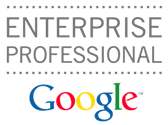 “We’re second only to the ad business in revenues,” he said. [Okay, a distant second, but still…] “Enterprise 2.0 is all about user choice and collaboration, as we move from individual to group productivity.” I loved Farber’s sarcastic comment here, that, if participation is really applied Web 2.0 style to the enterprise, “we can just have everyone vote — a great way to run a company!” He asked Satish Dharmaraj, the CEO of Zimbra, which he described as “the poster child for web apps in the enterprise, for his take on what such apps really do for a CIO. Satish answered they can reduce costs bigtime, such as those for updating thousands of desktops. Ross Mayfield, CEO of SocialText, said these new Web 2.0 tools also reduce search costs and time inside the company, and “they change the corporate culture by helping to stop the hoarding of information.” Glotzbach of Google reiterated that business is really moving from the individual knowledge worker, and that “it’s now about groups and collaboration.” We now need apps and tools that let individual users work the way they want within their many groups, which will vary from one to the other. Mayfield had a great comment here: “Kids grow up doing their homework on Facebook, which is called cheating. Then, when they get jobs in the real world, it’s called collaboration!”
“We’re second only to the ad business in revenues,” he said. [Okay, a distant second, but still…] “Enterprise 2.0 is all about user choice and collaboration, as we move from individual to group productivity.” I loved Farber’s sarcastic comment here, that, if participation is really applied Web 2.0 style to the enterprise, “we can just have everyone vote — a great way to run a company!” He asked Satish Dharmaraj, the CEO of Zimbra, which he described as “the poster child for web apps in the enterprise, for his take on what such apps really do for a CIO. Satish answered they can reduce costs bigtime, such as those for updating thousands of desktops. Ross Mayfield, CEO of SocialText, said these new Web 2.0 tools also reduce search costs and time inside the company, and “they change the corporate culture by helping to stop the hoarding of information.” Glotzbach of Google reiterated that business is really moving from the individual knowledge worker, and that “it’s now about groups and collaboration.” We now need apps and tools that let individual users work the way they want within their many groups, which will vary from one to the other. Mayfield had a great comment here: “Kids grow up doing their homework on Facebook, which is called cheating. Then, when they get jobs in the real world, it’s called collaboration!”  Farber asked the Zimbra CEO what he thought about employees wasting time online: “Certain people are going to goof off no matter what. They were doing it in the ’90s with GeoCities.” On the topic of online apps, Glotzbach said that Google’s emerged to let workers choose the way they want to work. “Is your entire company on these apps?” asked Farber. “Pretty much,” said Glotzbach, “but probably not the hardcore finance people — they’re not a replacement for their desktop apps.” Mayfield said SocialText created “SocialPoint,” which is a combination of wiki and Sharepoint functionality. “So, what do you guys offer to make a CIO replace Microsoft Office desktop apps?” asked Farber. “We probably can’t replace those,” Glotzbach said. “But we can meet special needs of some firms, such in the area of mobile apps.” Dharmaraj of Zimbra noted that Web 2.0 apps can be hosted in your own data center, and that this approach could be an option for firms wanting to shift from a Microsoft-centric environment. “And soon all web apps will have to have an offline component,” he said. “Mashups of all of us here are very possible and feasible,” said Google’s Glotzbach.
Farber asked the Zimbra CEO what he thought about employees wasting time online: “Certain people are going to goof off no matter what. They were doing it in the ’90s with GeoCities.” On the topic of online apps, Glotzbach said that Google’s emerged to let workers choose the way they want to work. “Is your entire company on these apps?” asked Farber. “Pretty much,” said Glotzbach, “but probably not the hardcore finance people — they’re not a replacement for their desktop apps.” Mayfield said SocialText created “SocialPoint,” which is a combination of wiki and Sharepoint functionality. “So, what do you guys offer to make a CIO replace Microsoft Office desktop apps?” asked Farber. “We probably can’t replace those,” Glotzbach said. “But we can meet special needs of some firms, such in the area of mobile apps.” Dharmaraj of Zimbra noted that Web 2.0 apps can be hosted in your own data center, and that this approach could be an option for firms wanting to shift from a Microsoft-centric environment. “And soon all web apps will have to have an offline component,” he said. “Mashups of all of us here are very possible and feasible,” said Google’s Glotzbach.  SocialText’s Ross Mayfield got the last word. “Standards are still needed. And it’s not just about developers anymore, but users doing apps,” he said. “You have to share control to add value.”
SocialText’s Ross Mayfield got the last word. “Standards are still needed. And it’s not just about developers anymore, but users doing apps,” he said. “You have to share control to add value.”
Joost: The last presentation of the morning’s general session was a demo of this new P2P television platform, by Dirk-Willem van Gulik of the Apache Software Foundation, who’s a board member of Joost. This platform, which formerly went by the code name of The Venice Project, is about “TV the way you want it…all the things you love about TV, including a high-quality full-screen picture, hundreds of full-length shows and easy channel-flipping.”  Co-founded by Niklas Zennström and Janus Friis, Joost claims to “fill a gap in the online video entertainment arena,” providing a premium interactive video experience, while guaranteeing copyright protection for content owners and creators. Van Gulik said the technology is “pure HTML and Javascript,” and he put on an awesome display of features and capabilities — I’m sure to the largest crowd yet to see this eye candy. Yes, the Web 2.0 faithful were well “Joost up” about the coming introduction of the live service, which van Gulik said would be “early this summer.” Meanwhile, if you’d like to try out the current beta client, go here and read about how you might try to get an invite. Also check out the Joost Blog, where you’ll learn they recently did their first deal with a major TV network, CBS.
Co-founded by Niklas Zennström and Janus Friis, Joost claims to “fill a gap in the online video entertainment arena,” providing a premium interactive video experience, while guaranteeing copyright protection for content owners and creators. Van Gulik said the technology is “pure HTML and Javascript,” and he put on an awesome display of features and capabilities — I’m sure to the largest crowd yet to see this eye candy. Yes, the Web 2.0 faithful were well “Joost up” about the coming introduction of the live service, which van Gulik said would be “early this summer.” Meanwhile, if you’d like to try out the current beta client, go here and read about how you might try to get an invite. Also check out the Joost Blog, where you’ll learn they recently did their first deal with a major TV network, CBS.
Well, it wasn’t a part of Web 2.0 Expo, but while I was here, I wanted to catch a big wing-ding last night at the Computer History Museum in Mountain View: Walt Mossberg and Kara Swisher’s launch party for their new Wall Street Journal AllThingsD.com web site. So, we bolted from Moscone West about 7:00 pm, with Aaron Fulkerson of MindTouch at the wheel. It looked like a Volvo, this car he rented, but I think it was actually a rocket ship. Either that or Aaron has received some serious tutoring in Formula One racing in his day. Tha man pushed it. But then we were running quite late for this gig. It was wild ride down the 101, white knuckles all the way (mine). Somehow we got there safe and sound, after almost losing it on a really sharp turn on the freeway exit, while he was telling me he once saw Steve Miller perform at the ampitheater close by. Anyway, it was great event, and we were glad we made the trip. Quite crowded — I’d say a few hundred people, luminaries everywhere. Couldn’t figure out why I was invited… 🙂 Here are some pix, first a few shot in the computer display area, including some with Aaron.
And here’s a shot of Walt (center) and his assistant Katie Boehret (far left), along with a couple other scenes in the lobby area of the venue, which is really quite nice (my first time there). But they don’t do justice to how crowded this party was…
Finally, after a couple glasses of some really great Pinot, I grabbed this shot of the whole AllThingD team. Everyone was there to celebrate all their hard work getting the site ready for its imminent launch. The second shot below is of Katie Boehret chatting with a guy from the Participatory Culture Foundation (sorry, forgot his name), whose mission is to build an open and democratic television platform. The third shot is of two guys from Google who work in new biz dev — Tom Sly, whom I met at Demo ’07, and Ronny Conway, son of legendary Silicon Valley angel, Ron Conway. Told him I’d met his dad, way back when. (Way to make a guy feel old, Ronny!) Fun guys! And the best shot I saved for last, of me doing my pose.pngth-famous-person shot with Kara Swisher. It was a fun time! Just wish I’d have thought to hit up Kara for a press pass to their next D Conference, coming up in May…. 🙂 Man, would I love to blog that baby.
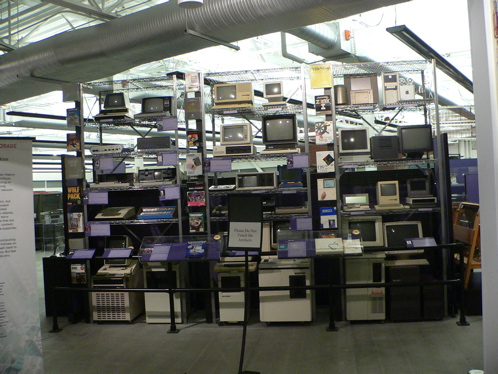



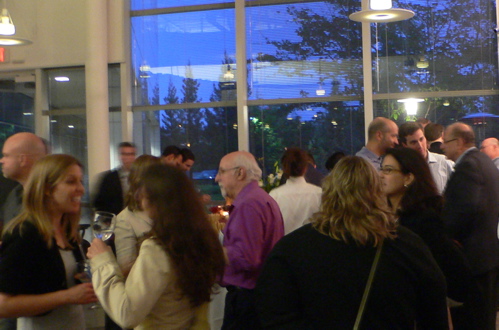
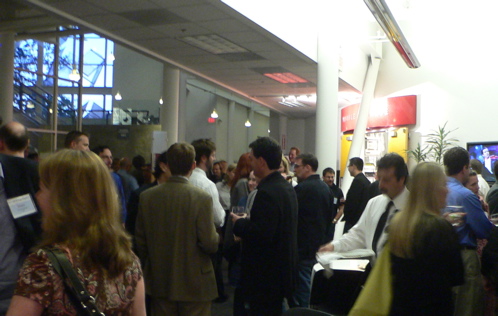

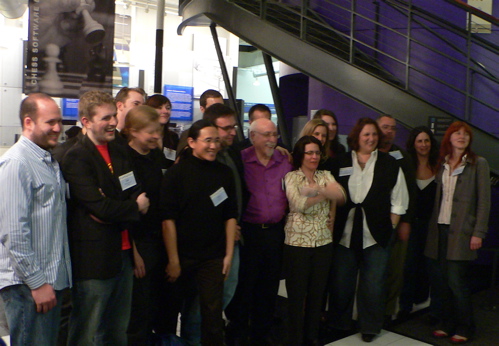
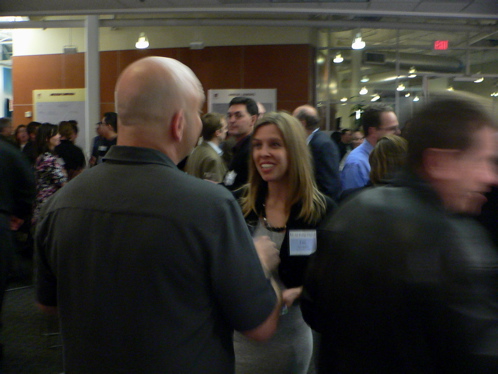
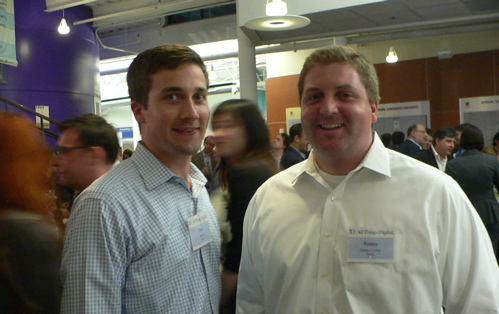
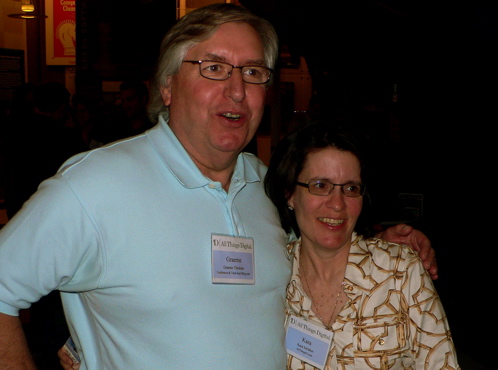

Recent Comments